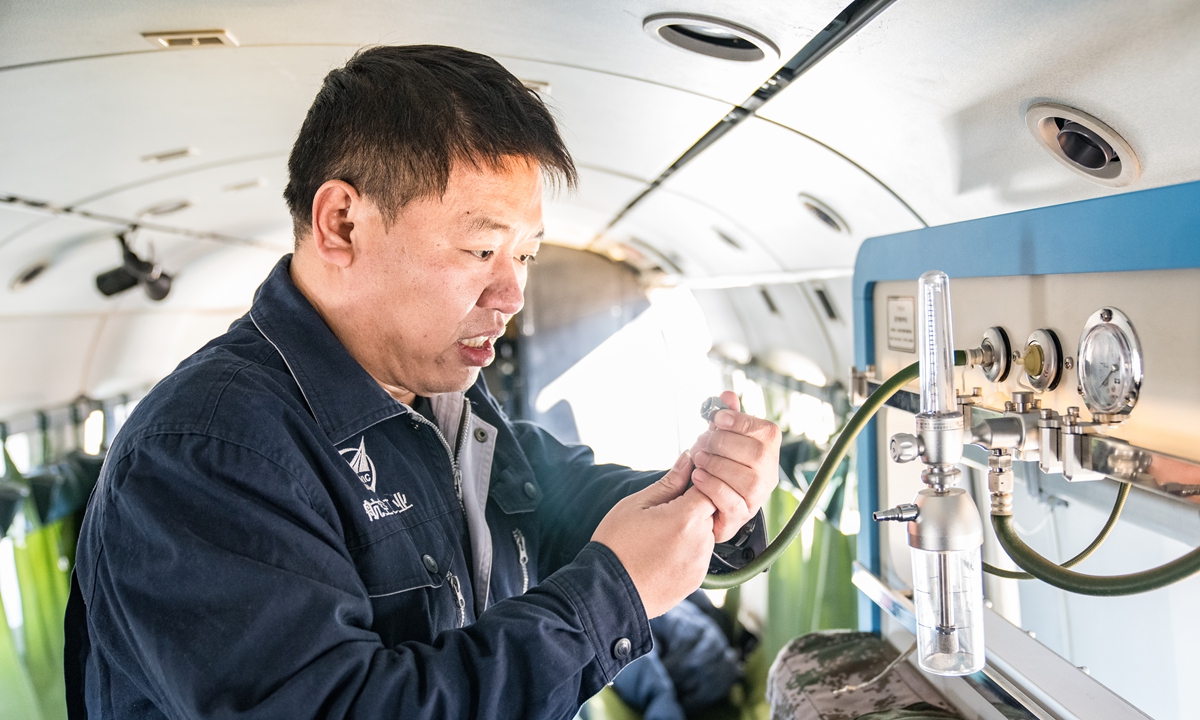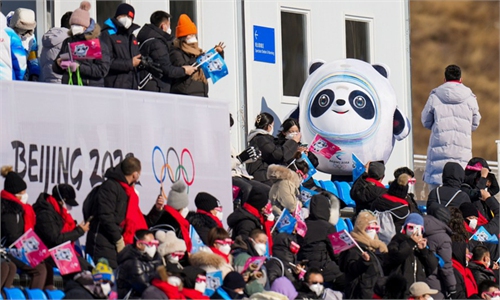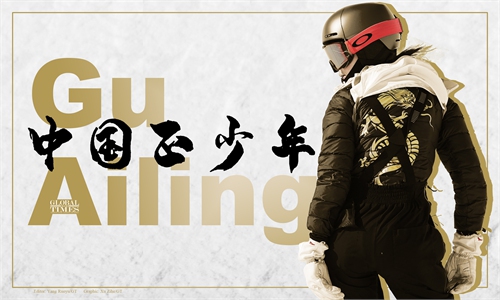
Rescuers fly a Chinese made helicopter in a rehearsal air rescue mission ahead of the Beijing 2022 Winter Olympics at Zhangjiakou, North China's Hebei Province on January 16, 2022. Photo: VCG
After more than six years of preparations, China is now in the middle of the 2022 Beijing Winter Olympics. A number of companies across the aviation industry have been devoting themselves to the Games for years.
From guaranteeing the torch relay to the entry of Olympic flights into Beijing, from meteorological guarantees to aviation fuel, the civil aviation industry has ramped up efforts to ensure a smooth operation of the Beijing Winter Olympics 2022 with meticulous support.
As far back as 2019, the Civil Aviation Administration of China (CAAC) set up a transport guarantee team for the major sports event. In December of 2021, the CAAC held a meeting and committed that the all units will fully support air transport for the Games, and work together to ensure the event be held safely and smoothly.
Air China, as an official partner airline of the Beijing 2022 Olympic and Paralympic Winter Games, fulfilled the task of flying the Olympic flame from Greece to Beijing. The airline was also responsible for transporting the Chinese delegation to the Tokyo 2020 Olympic and Paralympic Games last year.
Air China said in a release sent to the Global Times on Tuesday that it launched the luggage bar serving the Winter Olympics. Different from ordinary luggage bars, the version of the luggage bar is embedded with an RFID chip, which supports the whole process of luggage tracking, and passengers can check the transportation status of their luggage in the Air China APP.
As an elite international sports event, the Winter Olympics is a feat in large scale planning. At a time when the COVID-19 pandemic is still raging around the world, "safety" has become the primary guarantee for the success of the Winter Olympics.

Inset: A worker inspects medical equipment in the cabin of the helicopter in Zhangjiakou, North China's Hebei Province on January 15, 2022. Photo: VCG
Helicopter servicesThe Aviation Industry Corporation of China (AVIC) said on its official WeChat on February 5 that it arranged for three Z-8 aircraft for security and aviation rescue missions with their Zhangjiakou division, and their daily work includes inspecting Zhangjiakou Chongli Competition Area and Yunding Ski Resort.
Under normal circumstances, a Z-8 can escort two seriously injured individuals and nine patients suffering minor injuries at the same time. During the rescue, medical staff will use onboard facilities to perform physical monitoring, medical oxygen supply, life support and emergency treatment.
For the air rescue mission during the Beijing Winter Olympics, the team also installed the Beidou satellite navigation system and real-time image transmission equipment for the helicopter service, which is valuable for commanding rescue missions and tracking the flight status of the helicopter.
The biggest advantage of aviation medical rescue is its speed. It is 49 kilometers from Zhangjiakou aviation emergency rescue base to Chongli and 78 kilometers to Yanqing, but it only takes 15 minutes to reach Chongli by helicopter and less than 20 minutes to Yanqing.
Three aircraft under AVIC also undertook the support task of creating a snowy landscape for the Winter Games. In December 2021, a total of 25 hours of flight operations carried out and completed snowmaking in Zhangjiakou, North China's Hebei Province, creating a spectacular snow tracks for the Winter Olympics.
In addition, in November 2021, AVIC International won the bid for the Olympic Games Organizing Committee's helicopter insulation hangar project.
The project provides two inflatable thermal insulation hangars with a span of 36.5 meters, with wind resistance reaching level 11, ensuring that medical rescue helicopters can take off at any time in cold weather to perform emergency rescue missions during the competition, with the facility serving the two competition areas of Zhangjiakou and Yanqing.
China's customs also pledged to implement port epidemic prevention and control work for the Beijing Winter Olympics, and to ensure high-quality and efficient health quarantine and material clearance services for inbound Olympic personnel.
Beijing customs said it has applied 10 kinds of equipment and facilities including a disinfection cabinet, trace odor sniffer, and intelligent inspection robot at the front line of the port to enhance the intelligent customs clearance with efficiency.
As of January 29, Beijing customs had checked 178 planes and 8,018 Olympic-related personnel.
The weather center under CAAC North China Regional Administration said it has a clear and detailed plan to serve the Winter Games, especially personnel on duty must closely monitor weather conditions at major airports across the country and strengthen information reporting, submit detailed work procedures for low-visibility, strong winds, snowfall and frost and other high-frequency influence weather.
China National Aviation Fuel Group said that technologies including the Internet of Things, cloud computing, intelligent algorithms will provide critical support for aircraft refuelling while the Games are underway.



